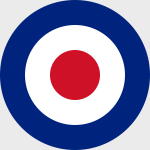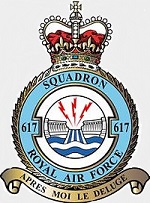Corgi AA32628 RAF Avro Lancaster B Mk. III Heavy Bomber - AJ-T, "T-Tommy", No.617 Squadron ('Dambusters'), Operation Chastise, RAF Scampton, May 1943 (1:72 Scale)
"Apres moi le deluge (French for 'After me, the flood')"
- Motto of No.617 Squadron
 Entering service at the beginning of 1942, the Lancaster's design grew out of a failed predecessor, the Avro Manchester. While its' airframe offered a stable platform for heavy bombing assignments, the Manchester's twin engine design was inadequate to the task. By upgrading to four Merlins, the resulting aircraft met the nation's needs and 7,366 Avro Lancasters were built during the war, the most of any British bomber. Armament included eight to ten Browning machine guns for fighter defense (depending on model variant) mounted in the nose, upper dorsal turret and the tail. Experience with a variety of bomb loads eventually led to adoption of the 'Grand Slam' 22,000-pound bomb, the largest carried by any aircraft in the war.
Entering service at the beginning of 1942, the Lancaster's design grew out of a failed predecessor, the Avro Manchester. While its' airframe offered a stable platform for heavy bombing assignments, the Manchester's twin engine design was inadequate to the task. By upgrading to four Merlins, the resulting aircraft met the nation's needs and 7,366 Avro Lancasters were built during the war, the most of any British bomber. Armament included eight to ten Browning machine guns for fighter defense (depending on model variant) mounted in the nose, upper dorsal turret and the tail. Experience with a variety of bomb loads eventually led to adoption of the 'Grand Slam' 22,000-pound bomb, the largest carried by any aircraft in the war.
The majority of Lancasters built during the war years were manufactured by Avro at their factory at Chadderton near Manchester and test flown from Woodford Aerodrome in Cheshire. Other Lancasters were built by Metropolitan-Vickers (1080, also tested at Woodford) and Armstrong Whitworth. The aircraft was also produced at the Austin Motor Company works in Longbridge, Birmingham later in the Second World War and postwar by Vickers-Armstrongs at Chester. Only 300 of the Lancaster B II fitted with Bristol Hercules engines were constructed; this was a stopgap modification caused by a shortage of Merlin engines as fighter production was of higher priority. Many BII's were lost after running out of fuel.
The Lancaster B III had Packard Merlin engines but was otherwise identical to contemporary B Is, with 3,030 B IIIs built, almost all at A.V. Roe's Newton Heath factory. The B I and B III were built concurrently, and minor modifications were made to both marks as new batches were ordered. Examples of these modifications were the relocation of the pitot head from the nose to the side of the cockpit, and the change from de Havilland "needle blade" propellers to Hamilton Standard or Nash Kelvinator made "paddle blade" propellers.
Of later variants, only the Canadian-built Lancaster B X, manufactured by Victory Aircraft in Malton, Ontario, was produced in significant numbers. A total of 430 of this type were built, earlier examples differing little from their British-built predecessors, except for using Packard-built Merlin engines and American-style instrumentation and electrics. Late-series models replaced the Frazer Nash mid-upper turret with a differently configured Martin turret, mounted slightly further forward for weight balance. A total of 7,377 Lancasters of all marks were built throughout the duration of the war, each at a 1943 cost of 45-50,000 (approximately equivalent to 1.3-1.5 million in 2005 currency).
For the dam-busting strike in May 1943, the Lancaster dropped British designer Barnes Wallis's 'bouncing bombs' which skipped on the surface before impact. Wartime Lancaster sorties totaled about 156,000 during which roughly 608,000 tons of ordnance were dropped on the enemy.
Pictured here is a 1:72 scale replica of a RAF Avro Lancaster B Mk. III heavy bomber that was nicknamed "T-Tommy", and attached to No.617 Squadron ('Dambusters'), then participating in Operation Chastise during May 1943.
Sold Out!
Dimensions:
Wingspan: 17-inches
Length: 11-3/4-inches
Release Date: April 2023
 Historical Account: "T for Tommy" - With the crews of the newly formed RAF No.617 Squadron now briefed on the targets they were being sent to attack, raid preparations for American pilot Flt Lt Joe McCarthy and his crew could hardly have been more challenging. Having practiced exhaustively in their usual aircraft ED915/AJ-Q 'Queenie', the crew discovered their Lancaster had developed a technical problem in the seconds immediately prior to taking off for 'Operation Chastise', the audacious RAF raid against the mighty dams of the Ruhr Valley. The issue was serious enough to force the crew to abandon their aircraft and transfer to reserve Lancaster ED825/G AJ-T 'Tommy' just minutes before they were due to take off. Their new aircraft eventually left Scampton at 22.01 hrs bound for arguably the most difficult target of the entire raid, the Sorpe Dam, which was protected by a huge earth bank.
Historical Account: "T for Tommy" - With the crews of the newly formed RAF No.617 Squadron now briefed on the targets they were being sent to attack, raid preparations for American pilot Flt Lt Joe McCarthy and his crew could hardly have been more challenging. Having practiced exhaustively in their usual aircraft ED915/AJ-Q 'Queenie', the crew discovered their Lancaster had developed a technical problem in the seconds immediately prior to taking off for 'Operation Chastise', the audacious RAF raid against the mighty dams of the Ruhr Valley. The issue was serious enough to force the crew to abandon their aircraft and transfer to reserve Lancaster ED825/G AJ-T 'Tommy' just minutes before they were due to take off. Their new aircraft eventually left Scampton at 22.01 hrs bound for arguably the most difficult target of the entire raid, the Sorpe Dam, which was protected by a huge earth bank.
Having practiced attacking targets flying low, straight and level towards them, they would instead have to drop their 'Upkeep' mine in a completely different manner. Flying low over the German village of Langscheid, they would have to avoid the tall steeple of the village church on the run-in, before diving steeply to extremely low altitude to fly along the length of the dam wall, dropping the non-spinning 'Upkeep' mine at exactly the halfway point. This attack approach proved so difficult that the aircraft's bomb aimer George Leonard 'Johnny' Johnson could not release the mine on nine previous attack runs, however on the tenth and whilst flying at a little over 30 feet, the Lancaster was perfectly aligned. Johnson shouted, 'Bomb gone!' over the intercom, much to the relief of the aircraft's crew, with the mine exploding exactly where intended, creating a huge crack in the structure. Unfortunately for them, the huge earth bank which supported the Sorpe Dam held firm, but would require extensive repair works to be undertaken in the weeks which followed the raid.
Lancaster ED825 arrived safely back at RAF Scampton at approximately 03.30 in the morning of May 17th, 1943, where the crew would learn that whilst the raid had been a success, the men of No.617 Squadron had paid a terrible price. Of the 19 Lancasters which had left the airfield only hours earlier, eight aircraft and their crews had failed to return. The bomb aimer onboard Lancaster ED825/G AJ-T 'Tommy' during its attack against the Sorpe Dam and the man with the responsibility for releasing the aircraft's 'Upkeep' mine was George Leonard 'Johnny' Johnson. Unless the aircraft was in the optimum position to deliver the mine on target, Johnson would not release the weapon, telling the pilot to go around and have another run at it. On that fateful night, it would take ten attack runs before he was happy to release the mine and allow the pilot to set course for home and their place in the history books.
At the age of 101, George Leonard 'Johnny' Johnson was the last surviving airman from the Dambusters raid, but sadly joined the rest of his comrades in early December last year. All 133 of the Dambusters heroes are now reunited once more.






